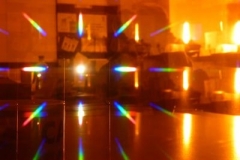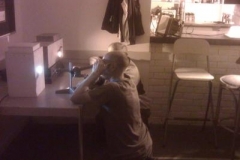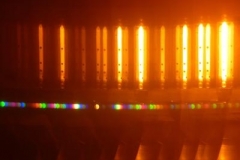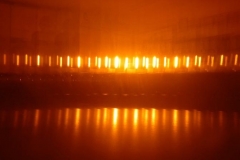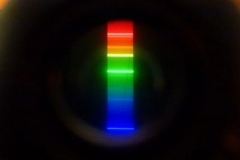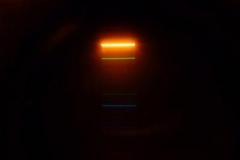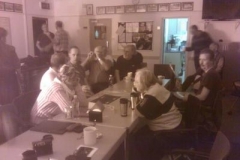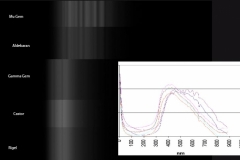Introduction
The splitting of light into it’s component parts, the spectrum, and especially the study of absorption and emission lines, can tell Astronomers the composition, density and temperature of an object such as a star or nebulae.
In recent years, with the advent of CCD and CMOS detectors amateur astronomers have been able to study spectroscopy, a science, which only recently was the domain of large telescopes and professional astronomers.
At Crayford we are starting up the Spectroscopy observation programme for any member who wishes to participate in this subject.
Getting Started
Equipment
The basic set-up is a telescope, diffraction grating or prism, and a detector (web cam, digital camera or CCD).
Diffraction gratings can be bought cheaply and mounted in front of a detector such as a DSLR, alternatively a cheap basic set-up can be bought in the form of a Star Analyser, this grating fits the same way as a 1.25″ filter.
A ‘free’, experimental, full aperture grating can be downloaded from the COAA website, the disadvantage of this grating is the lack of blazing, I can confirm that with my printer set to 800dpi and the printer set to print lines 3 dots wide and gaps 3 dots wide you do indeed get a spectra (tested with binoculars).
A more sophisticated set-up, designed by amateurs to do real science is the LHIRES III spectrograph from www.shelyak.com it is not cheap but probably gives the best value for money among the commercial offerings and is becoming the de-facto standard for amateur astronomers.
DIY Spectroscopes
DVD and CD’s are commonly used to make DIY spectroscopes, these work because the lines between each track are very close together, just like a diffraction grating.
- CD 1.6µm between lines
- DVD 0.74µm between lines
Here are instructions for a Solar spectroscope made from cardboard and a CD/DVD, ‘big’ Andy and Simon have made these in the past and they work well for educational use, you can see the Fraunhofer lines and the spectra of energy saving light bulbs. Martin has made a solar spectroscope from a DVD and DVD case which also works well, the instructions for this can be found here
A simple DIY spectroscope made from a cheap grating mounted in a 35mm slide.
Software
You will need software to process and analyse your spectra, we are still at the early stages of assessing the best software and techniques, but the following look promising candidates…
- AIP4Win2 – many members have this superb book and software.
In AIP4Win2 you can convert a spectrum into a text file that can be used in Open Office or MS Excel to produce a graph. - IRIS
- Visual Spec
In Visual spec you can calibrate your set-up and identify emission/absorption lines.A graphics programme such as the Freeware GIMP or Photoshop can be used to select a single line in the spectrum that can then be stretched to give a traditional looking spectra. such as the one for Betelgeuse Simon captured below (using AIP4Win2, Open Office and GIMP).

Variable Star Spectroscopy (VSS)
This presentation by Robin Leadbeater given at a BAA VSS workshop gives information about Variable Star Spectroscopy.
Spectra Night
Spectra Night – Thursday 13th August 2015
Below are a selection of fun photos from Honor Wheeler, Mike Rushton & Martin Crow of the evening member Debra Holton gave a talk about ‘Spectra’.
Honor has also provided a great summary of evening too – Thank you Honor.
”As part of our Beginner primer talks given by members, our week 11 Informal meeting became a Spectra Spectacular! Member Debra Holton introduced us to the universe in light, the Electromagnetic Spectrum, the Doppler shift relating to redshift and blue shift and the distances & velocities of Stars and Galaxies.
The evening began with the members becoming acquainted with a number of interesting implements such as Diffraction gratings & glasses along with professional and homemade Spectroscopes.
Debra began with a simple introduction to the wavelengths of light from the Radio to Gamma rays and our very own rainbow of colours from our Sun, the visible spectrum. She then went on to describe how we see the elements that surround us, that atoms absorb and emit photons and in doing so how we can observe the emissions or absorption lines to learn what the distant Stars and Galaxies are made of.
After a little refresher on the spectra of stars and the Doppler shift using online resources, we progressed to a little more down to earth investigation.
Following on from a rather energetic display of the Doppler shift utilizing a hairdryer (you had to be there!) we moved on to the spectra of different light sources.
Thanks also go to member Gordon Collings, who many years ago rescued old laboratory spectroscopes, light boxes and lamps, as we had the opportunity to observe the spectra of a Mercury light & Sodium light and to bathe in the rather eerie light of a Sodium lamp.
Thank you to Debra for a fun and educational evening and to Gordon for his Light entertainment (Sorry couldn’t resist!)”
Spectra of Comet C/2007 N3 Lulin

Note the spectra from the comet’s tail is different from the coma.
The tail emitting prominently in the blue/green end of the spectrum.
Spectra of the Great Orion Nebula M42
Imaging nebulae, like the Orion Nebula, shows why H alpha and OIII filters can really help in our light polluted skies.
DSLR Single Frame, 30s Exposure, limiting naked eye magnitude vMag = 4 By Simon Dawes
Spectroscopy of bright Stars
First light for Simon and Martin using their spectroscopes on bright stars
First Light for Simon!
My first attempt, the stars are not as well focused as I would like and I think the very short exposures (0.1s) have resulted in capturing the scintillation of the stars being observed resulting in wider lines than I think are possible with my set-up.


